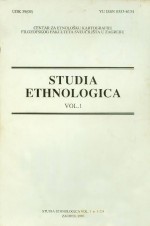Kuda idu "horvatski nomadi"
Where are "horvatski nomadi" (Croation nomads) going?
Author(s): Tomo VinšćakContributor(s): Snježana Veselica (Translator)
Subject(s): Customs / Folklore, Agriculture, Recent History (1900 till today), Cultural Anthropology / Ethnology, 19th Century
Published by: Sveučilište u Zagrebu, Filozofski fakultet
Keywords: cattleman; Croatian nomad; between the coast and Velebit; ethnology; alpine and transhumance cattle breeding;
Summary/Abstract: The transhumant mode of animal husbandry used to be practiced in the Appenines, in the Pyrenees, on the Caucasus, in the Near East, in Scotland and in the Balkans. In the Balkans this tradition has survived until today. Unlike nomads, the Velebit transhumants have head settlements which they leave in summer for pastures in the mountain while winter is spent in the warm seaside area. Up to the beginning of the twentieth century inhabitants of the base region of Velebit, inhabitants of the seaside area, and of Lika and Bukovica, depended for their maintenance on Velebit. Only the transhumant movements of shepherds from Bukovica to the pastures on south Velebit have survived until the present days. At the height of 1500 m above sea level they have shepherds- huts where they stay in June and August and return to their head households in Bukovica in Septem¬ber. At the beginning of winter they start moving again, taking sheep with them, but this time in the direction of the warm seaside area where they spend winter. From a present day point of view we are likely to conclude that this transhumant way of life will soon disappear, but we should be careful when drawing such a conclusion. It is a pity that a very useful line of production, such as transhumant sheep raising, is disappearing, particularly because it is the only ecologically justified mode of exploiting the mountain which does not destroy its natural harmony.
Journal: Studia ethnologica Croatica
- Issue Year: 1989
- Issue No: 1
- Page Range: 79-98
- Page Count: 20
- Language: Croatian

